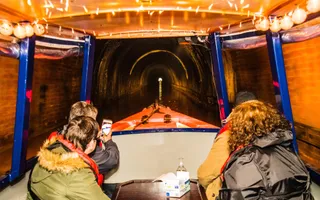At over 1.5 miles-long (2,676 metres), the Thomas Telford-built tunnel is a key point on the Trent & Mersey Canal, still navigated by thousands of canal boats each year, making it important for jobs and local tourism as well as the environmental and wildlife benefits that today’s navigable canals provide.
The most haunted on our network
On Wednesday 23 October, the week before Halloween, our tunnel specialists will use a boat mounted with an inspection platform to travel through the hand-dug tunnel – said to be the most haunted on the canal network.
The surveyors will painstakingly record the condition of the tunnel, assessing any structural changes, including checks for leaks, cracks and damaged brick work.
Harecastle Tunnel is one of the five longest fully navigable canal tunnels in the country. Hand dug using pick and shovel, Telford had the tunnel lined with millions of locally-made 19th century bricks.
There are two tunnels at Harecastle. The first tunnel, now disused, was designed by the ‘Father of the Canals’ James Brindley and completed in 1777: however, as demand for coal and freight increased, its limited capacity became a problem, and the second Telford tunnel was commissioned. Construction started 200 years ago, in 1824, and the tunnel opened in 1827.
A marvel of the Industrial Revolution
Jonathan Muir, our senior tunnel surveyor, said: “Built two centuries ago, Harecastle Tunnel is a marvel of the Industrial Revolution. It is vital that we give it the care and attention that it deserves, with every part of the network an important piece of the jigsaw to keep the canals open and alive.
“Inspecting the tunnel means travelling slowly through the tunnel, tapping the old bricks to ensure their structural integrity, measuring the profile of the tunnel to check for any movement, and monitoring for any leaks or cracks. The inspection will determine what maintenance and conservation repairs our charity needs to programme in.”
The Kidsgrove Boggart
Harecastle Tunnel has the reputation of one of the most haunted canal tunnels in Britain, home to the infamous Kidsgrove Boggart. It is said that a woman arrived in Kidsgrove on her way to join her husband in London. She accepted a lift with some boatmen and was murdered for the valuables in her luggage. Her body was hidden in a culvert off the main tunnel leading to Goldenhill colliery, known as ‘Gilberts Hole’: when her body was found, she had been beheaded.





